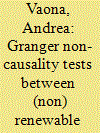| Srl | Item |
| 1 |
ID:
113432


|
|
|
|
|
| Publication |
2012.
|
| Summary/Abstract |
The present paper considers an Italian dataset with an annual frequency from 1861 to 2000. It implements Granger non-causality tests between energy consumption and output contrasting methods allowing for structural change with those imposing parameter stability throughout the sample. Though some econometric details can differ, results have clear policy implications. Energy conservation policies hasten an underlying tendency of the economy towards a more efficient use of fossil fuels. The abandonment of traditional energy carriers was a positive change. The challenge for renewable energy is to diversify among different sources and to overcome possible social acceptance problems.
|
|
|
|
|
|
|
|
|
|
|
|
|
|
|
|
| 2 |
ID:
161778


|
|
|
|
|
| Summary/Abstract |
This paper examines the sources of economic growth and the nature of industrial structure change in China over the past decade, with a comparison to those in Russia. It shows that over the observation period between 1995 and 2008, the Chinese economy was concentrated relatively more in the manufacturing sector and relatively less in the service sector than the Russian economy. In addition, this paper finds that the higher economic growth rate in real GDP and aggregate labour productivity growth between 1996 and 2008 in China than in Russia was broadly based, with most industries contributing to China's better performance. Furthermore, it reveals that the acceleration in economic growth in China in 2003–2008 over 1996–2002 was mainly traced to an increased contribution from the manufacturing sector and to a lesser degree the service sector, while in Russia, it was the service sector, followed by the primary sector driven by the mining and oil and gas extraction industry. These results suggest that the Chinese and Russian economies complement each other, which bodes well for further economic cooperation and trade between the two countries.
|
|
|
|
|
|
|
|
|
|
|
|
|
|
|
|
| 3 |
ID:
121342


|
|
|
|
|
| Publication |
2013.
|
| Summary/Abstract |
This paper investigated the causal relationship between energy consumption and gross domestic product (GDP) in China at both aggregated and disaggregated levels during the period of 1978-2009 by using a modified version of the Granger (1969) causality test proposed by Toda and Yamamoto (1995) within a multivariate framework. The empirical results suggested the existence of a negative bi-directional Granger causality running from aggregated energy consumption to real GDP. At disaggregated level of energy consumption, the results were complicated. For coal, empirical findings suggested that there was a negative bi-directional Granger causality running from coal consumption to real GDP. However, for oil and gas, empirical findings suggested a positive bi-directional Granger causality running from oil as well as gas consumption to real GDP. Though these results supported the feedback hypothesis, the negative relationship might be attributed to the growing economy production shifting towards less energy intensive sectors and excessive energy consumption in relatively unproductive sectors. The results indicated that policies with reducing aggregated energy consumption and promoting energy conservation may boost China's economic growth.
|
|
|
|
|
|
|
|
|
|
|
|
|
|
|
|